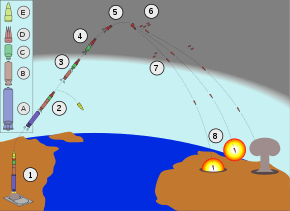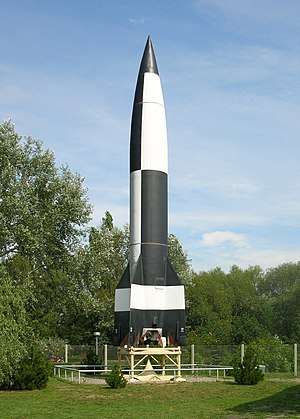Ballistic missile
A ballistic missile follows a ballistic trajectory to deliver one or more warheads on a predetermined target. These weapons are guided only during relatively brief periods—most of the flight is unpowered. Short-range ballistic missiles stay within the Earth's atmosphere, while intercontinental ballistic missiles (ICBMs) are launched on a sub-orbital trajectory.

- 1. The missile launches out of its silo by firing its 1st-stage boost motor (A).
- 2. About 60 seconds after launch, the 1st-stage drops off and the 2nd-stage motor (B) ignites. The missile shroud (E) is ejected.
- 3. About 120 seconds after launch, the 3rd-stage motor (C) ignites and separates from the 2nd stage.
- 4. About 180 seconds after launch, 3rd-stage thrust terminates and the Post-Boost Vehicle (D) separates from the rocket.
- 5. The Post-Boost Vehicle maneuvers itself and prepares for re-entry vehicle (RV) deployment.
- 6. The RVs, as well as decoys and chaff, are deployed.
- 7. The RVs (now armed) and chaff re-enter the atmosphere at high speeds.
- 8. The nuclear warheads detonate.
These weapons are in a distinct category from cruise missiles, which are aerodynamically guided in powered flight.
History

The earliest form of ballistic missiles dates from the 13th century with its use derived from the history of rockets. In the 14th century, the Ming Chinese navy used an early form of a ballistic cruise missile weapon called the Huo long chu shui in naval battles against enemy ships.[1] A modern pioneer ballistic missile was the A-4,[2] commonly known as the V-2 developed by Nazi Germany in the 1930s and 1940s under the direction of Wernher von Braun. The first successful launch of a V-2 was on October 3, 1942, and it began operation on September 6, 1944, against Paris, followed by an attack on London two days later. By the end of World War II in Europe in May 1945, more than 3,000 V-2s had been launched.[3]
The R-7 Semyorka was the first intercontinental ballistic missile.
A total of 30 nations have deployed operational ballistic missiles. Development continues with around 100 ballistic missile flight tests in 2007 (not including those of the US), mostly by the People's Republic of China, Iran, and the Russian Federation. In 2010, the U.S. and Russian governments signed a treaty to reduce their inventory of intercontinental ballistic missiles (ICBMs) over a seven-year period (to 2017) to 1550 units each.[4]

Flight
An intercontinental ballistic missile trajectory consists of three parts: the powered flight portion; the free-flight portion, which constitutes most of the flight time; and the re-entry phase, where the missile re-enters the Earth's atmosphere. (The flight phases for shorter-range ballistic missiles are essentially the first two phases of the ICBM, as some ballistic categories do not leave the atmosphere.)
Ballistic missiles can be launched from fixed sites or mobile launchers, including vehicles (e.g., transporter erector launchers (TELs)), aircraft, ships, and submarines. The powered flight portion can last from a few tenths of seconds to several minutes and can consist of multiple rocket stages.
When the fuel is exhausted, no more thrust is provided and the missile enters free flight. In order to cover large distances, ballistic missiles are usually launched into a high sub-orbital spaceflight; for intercontinental missiles, the highest altitude (apogee) reached during free-flight is about 2,000 kilometers (1,200 mi).[5]
The re-entry stage begins at an altitude where atmospheric drag plays a significant part in missile trajectory, and lasts until missile impact.
Reentry vehicles reenter the Earth's atmosphere at very high velocities, on the order of 6–8 kilometers per second (22,000–29,000 km/h; 13,000–18,000 mph) at ICBM ranges.[6]
Advantages
The course taken by ballistic missiles has two significant desirable properties. First, ballistic missiles that fly above the atmosphere have a much longer range than would be possible for cruise missiles of the same size. Powered rocket flight through thousands of kilometers of air would require vastly greater amounts of fuel, making the launch vehicles larger and easier to detect and intercept. Powered missiles that can cover similar ranges, such as cruise missiles, do not use rocket motors for the majority of their flight, but instead use more economical jet engines. However, cruise missiles have not made ballistic missiles obsolete, due to the second major advantage: ballistic missiles can travel extremely quickly along their flight path. An ICBM can strike a target within a 10,000 km range in about 30 to 35 minutes. With terminal speeds of over 5,000 m/s, ballistic missiles are much harder to intercept than cruise missiles, due to the much shorter time available. Therefore, ballistic missiles are some of the most feared weapons available, despite the fact that cruise missiles are cheaper, more mobile, and more versatile.
Types

Ballistic missiles do vary widely in range and use, and are often divided into categories based on range. Various schemes are used by different countries to categorize the ranges of ballistic missiles:
- Air-launched ballistic missile (ALBM)
- Tactical ballistic missile: Range between about 150 km and 300 km
- Theatre ballistic missile (TBM): Range between 300 km and 3,500 km
- Short-range ballistic missile (SRBM): Range between 300 km and 1,000 km
- Medium-range ballistic missile (MRBM): Range between 1,000 km and 3,500 km
- Intermediate-range ballistic missile (IRBM) or long-range ballistic missile (LRBM): Range between 3,500 km and 5,500 km
- Intercontinental ballistic missile (ICBM): Range greater than 5,500 km
- Submarine-launched ballistic missile (SLBM): Launched from ballistic missile submarines (SSBNs)
Most current designs have intercontinental range with a notable exception of Indian operational SLBM Sagarika and K-4 as well as North Korea's currently operationally deployed KN-11[7] which might not have intercontinental range. A comparable missile would be the decommissioned China's JL-1 SLBM with a range of less than 2,500 km.
Tactical short- and medium-range missiles are often collectively referred to as tactical and theatre ballistic missiles, respectively. Long- and medium-range ballistic missiles are generally designed to deliver nuclear weapons because their payload is too limited for conventional explosives to be cost-effective in comparison to conventional bomber aircraft (though the U.S. is evaluating the idea of a conventionally armed ICBM for near-instant global air strike capability, despite the high costs).
Quasi ballistic missiles
A quasi ballistic missile (also called a semi ballistic missile) including anti-ship ballistic missiles is a category of missile that has a low trajectory and/or is largely ballistic but can perform maneuvers in flight or make unexpected changes in direction and range.
At a lower trajectory than a ballistic missile, a quasi ballistic missile can maintain higher speed, thus allowing its target less time to react to the attack, at the cost of reduced range.
The Russian Iskander is a quasi ballistic missile.[8] The Russian Iskander-M cruises at hypersonic speed of 2,100–2,600 m/s (Mach 6–7) at a height of 50 km. The Iskander-M weighs 4,615 kg carries a warhead of 710–800 kg, has a range of 480 km and achieves a CEP of 5–7 meters. During flight it can maneuver at different altitudes and trajectories to evade anti-ballistic missiles.[9][10]
China, India & Iran have recently developed anti-ship ballistic missiles;
List of quasi ballistic missiles
- Hadès (retired)
- Prithvi-III (active)
- Dhanush (active)
- Prahaar (underdevelopment)
- Shaurya (underdevelopment)
- LORA (active)
- Nasr (active)
- MGM-140B/E ATACMS (active)
Throw-weight
Throw-weight is a measure of the effective weight of ballistic missile payloads. It is measured in kilograms or tonnes. Throw-weight equals the total weight of a missile's warheads, reentry vehicles, self-contained dispensing mechanisms, penetration aids, and missile guidance systems: generally all components except for the launch rocket booster and launch fuel. Throw-weight may refer to any type of warhead, but in normal modern usage, it refers almost exclusively to nuclear or thermonuclear payloads. It was once also a consideration in the design of naval ships and the number and size of their guns.
Throw-weight was used as a criterion in classifying different types of missiles during Strategic Arms Limitation Talks between the Soviet Union and the United States.[11] The term became politically controversial during debates over the arms control accord, as critics of the treaty alleged that Soviet missiles were able to carry larger payloads and so enabled the Soviets to maintain higher throw-weight than an American force with a roughly comparable number of lower-payload missiles.[12]
The missiles with the world's heaviest payloads are the Russian SS-18 and Chinese CSS-4 and Russia is developing a new heavy-lift, liquid-propellant ICBM called the Sarmat.[6]
Depressed trajectory
Throw-weight is normally calculated using an optimal ballistic trajectory from one point on the surface of the Earth to another. An optimal trajectory maximizes the total payload (throw-weight) using the available impulse of the missile. By reducing the payload weight, different trajectories can be selected, which can either increase the nominal range or decrease the total time in flight.
A depressed trajectory is a non-optimal, as a lower and flatter trajectory takes less time between launch and impact but has a lower throw-weight. The primary reasons to choose a depressed trajectory are to evade anti-ballistic missile systems by reducing the time available to shoot down the attacking vehicle (especially during the vulnerable burn-phase against space-based ABM systems) or a nuclear first-strike scenario.[13] An alternate, non-military, purpose for a depressed trajectory is in conjunction with the space plane concept with use of air-breathing engines, which requires the ballistic missile to remain low enough inside the atmosphere for air-breathing engines to function.
See also
- Anti-ballistic missile
- List of ICBMs
- List of NATO reporting names for ballistic missile submarines
- Surface-to-surface missile
- Weapons of mass destruction
- List of missiles
- List of missiles by nation
- List of currently active missiles of the United States military
- NATO reporting name (has lists of various Soviet missiles)
- Payload
- MIRV
- Ballistic missile flight phases
Notes
- Needham, Volume 5, Part 7, 508-510.
- Zaloga, Steven (2003). V-2 Ballistic Missile 1942–52. Reading: Osprey Publishing. p. 3. ISBN 978-1-84176-541-9.
- Clayton K. S. Chun (2006). Thunder Over the Horizon: From V-2 Rockets to Ballistic Missiles. Greenwood Publishing Group. p. 54.
- U.S. Department of State (8 April 2010). "Treaty between the United States of America and the Russian Federation on Measures for the Further Reduction and Limitation of Strategic Offensive Arms". Retrieved 25 November 2018.
- Almasy, Steve; Kwon, K. J.; Lee, Taehoon (14 May 2017). "North Korea launches missile". CNN. Retrieved 2017-10-14.
- "Ballistic and Cruise Missile Threat". Defense Intelligence Ballistic Missile Analysis Committee. June 2017.
- (2nd LD) N.K. leader calls SLBM launch success, boasts of nuke attack capacity—Yonhap, 25 Aug 2016 08:17am
- Shaurya surfaces as India's underwater nuclear missile
- SS-26 Iskander-M
- SS-26 Stone Iskander 9M72 9P78EBallistic missile system Archived 2010-07-25 at the Wayback Machine
- James John Tritten, Throw-Weight and Arms Control, Air University Review, Nov-Dec 1982.
- New York Times, What Is Throw-Weight?, July 15, 1991.
- Science & Global Security, 1992, Volume 3, pp.101-159 Depressed Trajectory SLBMs: A Technical Evaluation and Arms Control Possibilities
References
- Needham, Joseph (1986). Science and Civilization in China: Volume 5, Chemistry and Chemical Technology, Part 7, Military Technology; the Gunpowder Epic. Taipei: Caves Books Ltd.
Further reading
- Futter, Andrew (2013). Ballistic Missile Defence and US National Security Policy: Normalisation and Acceptance after the Cold War. Routledge. ISBN 978-0415817325.
- Neufeld, Jacob (1990). The Development of Ballistic Missiles in the United States Air Force, 1945-1960. Office of Air Force History, U.S. Air Force. ISBN 0912799625.
- Swaine, Michael D.; Swanger, Rachel M.; Kawakami, Takashi (2001). Japan and Ballistic Missile Defense. Rand. ISBN 0833030205.